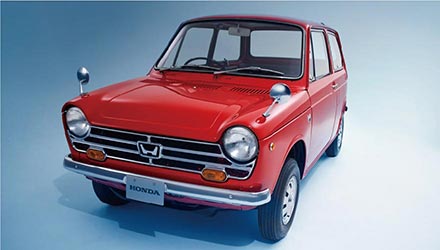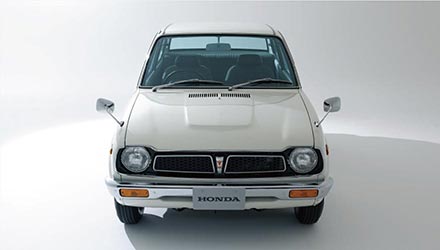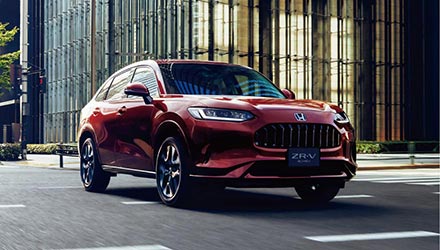The Challenge to Produce the 60° V6 J Engine Independently
in the U.S.
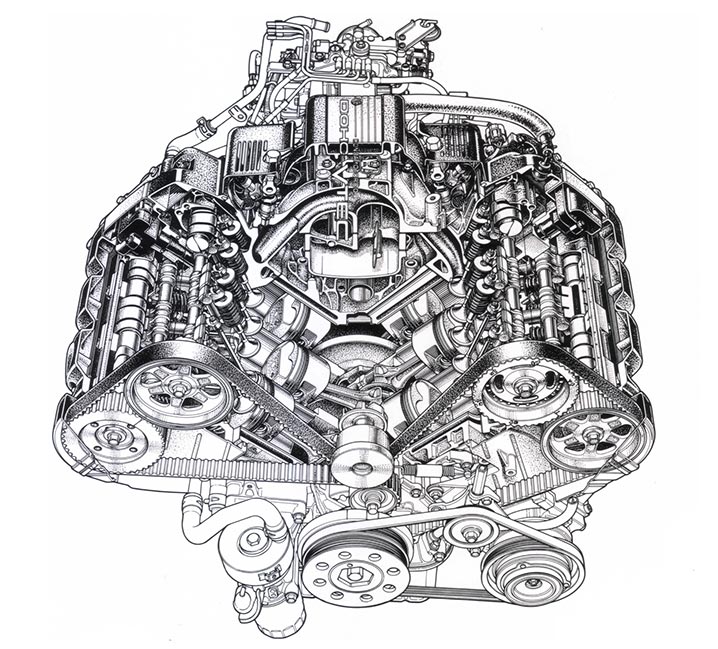 NSX’s 3.0L V6 C30A engine
NSX’s 3.0L V6 C30A engine
In 1993, the development of a new V6 engine series was planned in order to create price-competitive V6 engine-powered cars in North America. Koichi Fukuo (former Director and Senior Managing Executive Officer) was assigned as Large Project Leader (LPL) for engine development. Fukuo was the developer in charge of the underbody design of the 2.0L and 2.5L 90° V6 C engines for the Legend launched in 1985. The 90° V6 engine was Honda’s first V6, and broke down constantly during development. The solution, designing the engine with a wide margin in terms of durability, proved to be successful, and after displacement was increased to 2.7L in 1987, and updated as a DOHC VTEC 3.0L engine in 1990, was selected for the NSX in 1990, and with further increase to 3.2L, the Legend. It went on to become famous as an unbreakable engine through SUPER GT*15 racing. The successor to this V6 engine was developed as the J engine.
For this J engine, Honda opted for SOHC partly due to making models equipped with this engine more price-competitive. Fukuo had the idea that the SOHC engine would be simpler if it could achieve superior performance as well as price, and that it could be combined with the roller rocker arm VTEC that was under development at the time to create a lightweight, compact engine that would balance environment, performance, and cost at a core level. He wanted to create a good design that would leave its mark on history.
Honda often develops different engines for different models, which is not efficient either in terms of engine design or business. With this background in mind, the J engine was envisioned from the beginning to be a series of 2.5L to 3.5L engines. Furthermore, Fukuo became the acting LPL for all subsequent models powered by J engines, and when the LPL said he wanted to change the engine, Fukuo argued the necessity of the J engine, even insisting that the business feasibility by only producing J engines be considered. Unifying the front and rear of the cylinder heads, the first time for a Honda V6, aimed at eradicating the need to use tools to remove cylinder block sleeve burrs, came from a business perspective. Fukuo said, “From a business standpoint, but also from quality and efficiency considerations, we thought it was most important to make an engine that was easy to manufacture.”
There was another big challenge; To realize independent production in the U.S., where the original engine was not available and a new engine had to be built from scratch. At the time, the high, 80 yen exchange rate led to demands for local production. Honda was also looking to procure 100% of its parts locally. Concurrent to engine development, Fukuo traveled to the U.S. often to visit parts manufacturers and selected local suppliers.
 Odyssey Prestige
Odyssey Prestige
 In Japan, the J30A engine powered models such as
In Japan, the J30A engine powered models such as the Odyssey Prestige and Avancier
On the other hand, only Japanese suppliers could manufacture VTEC rocker arms, which require high precision, so Fukuo tried enthusiastically to convince them to expand their business to the United States. He felt that since he had made the request, he also had to provide support, so he visited the suppliers who had expanded into the U.S., inspected their production, and met with their staff who were having difficulties during their first time working abroad.
As a result of these efforts, with not only development but production and purchasing teams working as one, the J30A J-type 3.0L V6 engine was selected for the 1996 Acura CL. In 1998, the larger 3.2L J32A engine powering the Acura TL Type S achieved 260 PS. In 2023, a 355 PS version with variable cylinder management (VCM)*16, the most powerful J engine, was added to the ACURA TLX Type S, and the series continues to evolve as an important engine that supports Honda’s profitability in North America.
- High-performance GT car-based racing car series in Japan.
- Technology that automatically deactivates combustion in some engine cylinders depending on driving conditions.
R Engine Pursues Fun Driving in Ordinary Use
and World-Class Fuel Economy
In 2001, after the Accord’s DOHC i-VTEC*17 K engine was launched and development of the i-DSI L engine for compact cars was complete, Honda began plans to develop an engine that fits between the two engines in size, and plays a large role in its new generation power plants. Discussions proceeded with three options: continue with the conventional engine, develop a smaller version of the Accord-class engine, or start design from scratch. The verdict was to develop a completely new engine for the Civic. The newly-christened R engine was to be a 1.8L engine with the low-speed torque of a 2.0L engine and fuel economy of a l.5L engine.
Shigemasa Kajiwara, then PL of development, decided to use a three-valve engine with two spark plugs, which had been successfully used in the earlier development of the i-DSI. When the prototype was tested on the bench, both output and fuel economy were perfect. However, its rumbling noise was too loud.
“It sounded awful,” recalled Kajiwara. The sound was caused by the crank twisting due to rapid combustion and knocking. It was a sound that Kajiwara could not stand. The mass-production system was soon to be set in motion, but Kajiwara made the decision to drastically change the design, one day before a regular meeting. Immediately after informing the team of his decision, Kajiwara punched a wall on the staircase landing at the laboratory. He was angry at himself, wondering why he had not anticipated this sound from the beginning. The evaluators accepted Kajiwara’s sudden decision. They would not stand in the way if the development team thought the change was required. Honda would not force them to do anything. They would do it on their own. That is the Honda way.
Kajiwara then changed the valve mechanism to an orthodox 4-valve system, with one spark plug per cylinder. Of course, this was not the end of the story, because they were aiming to achieve the world’s best fuel economy. To do this, one of the VTEC’s intake valves was changed to delay its closing. During low-load driving, such as cruising, the throttle is usually not opened much because the driver does not depress the accelerator pedal, but the drive-by-wire (electronically controlled throttle, or DBW) opens the throttle slightly to reduce pumping loss. Instead, the intake valve is closed with a delay to push the intake air mixture back to the ports to obtain sufficient torque. When high power and torque are required, such as during take-off, VTEC is switched to maximize intake air filling efficiency. As a result, fuel economy equivalent to that of a 1.5-liter engine during cruise and output equivalent to that of a 2.0-liter engine during take-off were achieved. Kajiwara believed the precise control to improve fuel economy was unparalleled.

“Delayed closing" of VTEC intake valves
Intake valve and throttle valve control during cruising
Of course, this control not only involved intake valve switching, but also a variable pipe length intake manifold, which controls lengthens the pipe at low engine speeds, and shortens it at high revs for optimum intake inertia at all times. In addition, piston oil jets that blow oil to effectively cool the pistons was also employed. At the time, piston oil jets were originally used in racing engines that required durability at high revs, and a handful of high-end production models from each automaker. The cooling effect of the oil sprayed on the piston improved knocking resistance even in the low rev range, and enabled a higher compression ratio and more flexible ignition timing. The result was higher torque throughout the entire range, especially at low speeds, which is often used for starting and accelerating in urban areas.
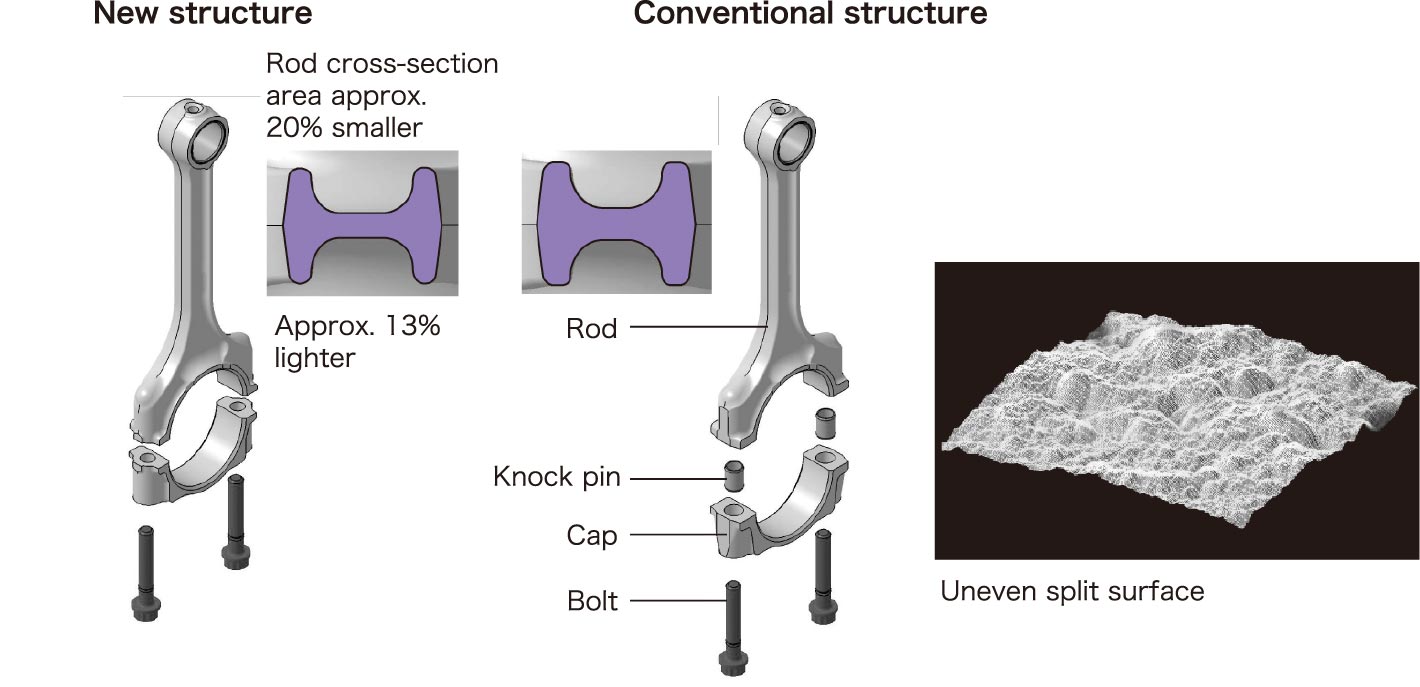
Cracked connecting rods designed to be lighter and to reduce the number of machining operations.
 2005 Civic’s 1.8L inline 4-cylinder
2005 Civic’s 1.8L inline 4-cylinder SOHC i-VTEC R engine
In addition, for lighter weight and higher revs, cracked connecting rods, in which the large end of the hot-forged, high-strength connecting rod is cracked, were used. This resulted in a lighter engine requiring less machining operations compared to conventional engines, and through reduced inertial weight, the crankshaft could also be made lighter.
Furthermore, friction in various parts was drastically reduced to complete the lightweight, compact, high output, low fuel consumption 1.8L inline 4-cylinder SOHC i-VTEC R engine. Although it was a simple, relatively low-tech SOHC engine, Kajiwara was confident of how fun it made driving, even at low speeds. Within Honda, many felt that high-revving engines defined Honda, and the engine was too focused on the normal use range, but the market felt otherwise, praising it as a “uniquely Honda” engine that was a joy to drive in the city. Kajiwara placed importance on “whether it is fun to drive or not.” Fun, is not just about specifications; and there are a number of ways to achieve it.
- Intelligent VTEC
The Engine Acting as The Bridge to Electrification
After launching the highly efficient U.S. produced V6 engine, Honda began development of V8 and V10 engines for the super sports car to replace the NSX. A test model was completed, and the engine was at a mature stage, but in the wake of the 2008 global financial crisis, Takeo Fukui, then the sixth president, decided to discontinue development. Meanwhile, the tightening of environmental regulations in response to global warming was becoming a major issue, such as the stricter emission regulations in the U.S. state of California, which required a certain percentage of zero-emission vehicles (ZEVs) to be sold.
Honda has prided itself on being ahead of the curve in meeting strict environmental regulations since its challenge to conform to the Muskie Act. Honda began development of a new engine series, the L engine series, which aimed to achieve unprecedented high-efficiency, while meeting ever-stricter environmental regulations of the coming era that would continue to emphasize the environment, and still have the best driving pleasure unique to Honda. Honda decided to take a two-pronged approach with the L engine: a naturally aspirated engine, and a turbocharged engine aimed at downsizing. “Associates who have been involved in the development of successive generations of power units at Honda believe that its power unit development philosophy is to value environmental performance while also aiming for the top in performance. We worked enthusiastically to develop the ultimate engine series that may be the last of its kind before the age of electrification,” said Yuji Matsumochi, then General Manager of the Engine Management Department at Honda R&D’s Automobile Operations Monozukuri Center.
Developing the New Generation, Small Displacement,
Naturally-Aspirated L Engine
The first L engines were the third-generation Fit’s 1.3L and 1.5L naturally aspirated L engines in 2013. All engines were DOHC with VTEC and VTC, using either Atkinson cycle (1.3L) or direct injection (1.5L) according to the aim of each powertrain, and an idling stop system to achieve the top-level (at the time, according to Honda research) fuel economy in the 1.3L class and driving pleasure simultaneously.

1.3L naturally-aspirated Atkinson-cycle L engine

1.5L naturally-aspirated direct injection L engine
Developing the New Generation Down-sized Turbo Engine
 1.5L downsized L15B turbo engine
1.5L downsized L15B turbo engine
Honda then developed the 1.5L VTEC TURBO L15B engine for the Step Wagon released in 2015. By employing direct injection to lower combustion chamber temperature to prevent knocking, and VTC for both air intake and exhaust to increase the degree of freedom of valve overlap control, pumping loss was reduced. The turbo employed a small-diameter turbine to improve response in the low rpm range. In addition, by freely controlling the turbo’s boost pressure with an electric wastegate and the amount of overlap according to driving conditions, the engine achieved torque equivalent to that of a 2.4L engine while achieving the top level fuel economy in its class at the time (according to Honda research) as a 1.5L to 2.0L-class minivan. This engine was first used in the Step Wagon, and then in the Civic starting in 2017. It was further evolved into the L15C engine which powered the ZR-V in 2022, supporting the driving performance of a wide range of Honda’s gasoline-powered cars while continuing to evolve.
Developing the New Generation High-Powered
K20C Turbo Engine
In parallel with the VTEC TURBO engine, the K20C engine was developed for use in successive Civic Type R models from 2015 to 2022. The development challenges were “more than 300 PS” and “not to break down at the Nürburgring”*18. The small-diameter mono-scroll turbocharger with high response and an electric wastegate, VTC on the intake and exhaust sides, and VTEC on the exhaust side were used to improve intake and exhaust efficiency and reduce pumping loss. To ensure compliance with emission regulations 10 years from now, combustion was refined with various technologies aimed at stoichiometric (theoretical air-fuel ratio or below) combustion throughout the entire range of LFC engines for e:HEV (described below), achieving its goals of high output exceeding 300 PS, low fuel consumption, and low emissions.
“Sodium-filled valves and other technologies that were once used in racing cars are now being used by Honda in everything from k-cars to big V6 engines. Honda's approach to development is to use any technology that is necessary without second-thought,” said Matsumochi, then PL.
This does not imply that cost was not a consideration. Honda has made meticulous efforts to reduce costs by taking advantage of in-house manufacturing, producing difficult parts in-house, eliminating unnecessary parts and replacing them with more cost-effective materials through design, and making its own manufacturing processes more efficient.
- Racing track located in Nürburg, Germany. The north course, which is over 20 km long, is a difficult course with many turns, uneven road surfaces and elevation changes, and is used by automobile manufacturers from various countries for testing and time attacks.
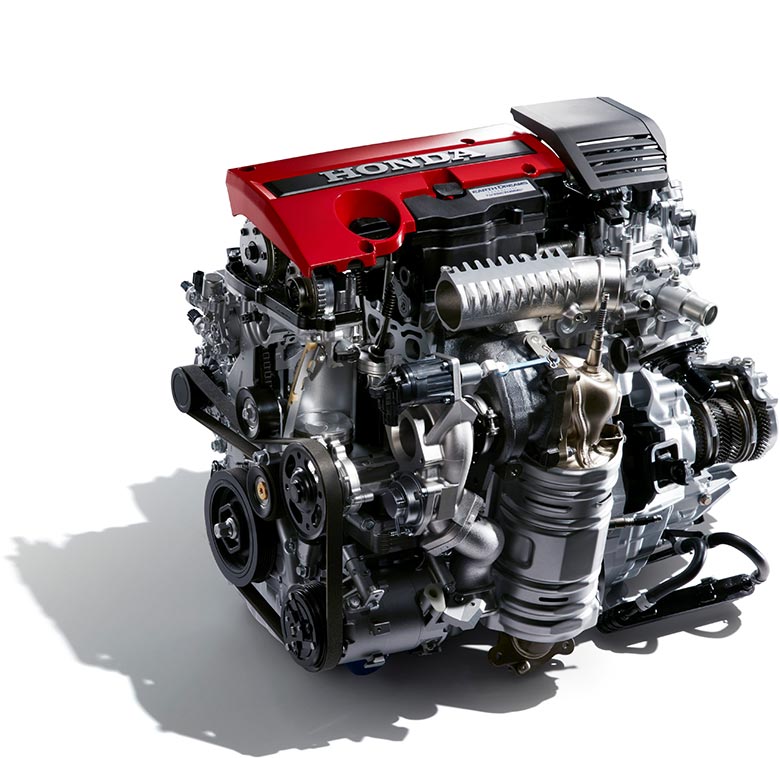
K20 engine that powered Civic Type Rs
from 2015 to 2022
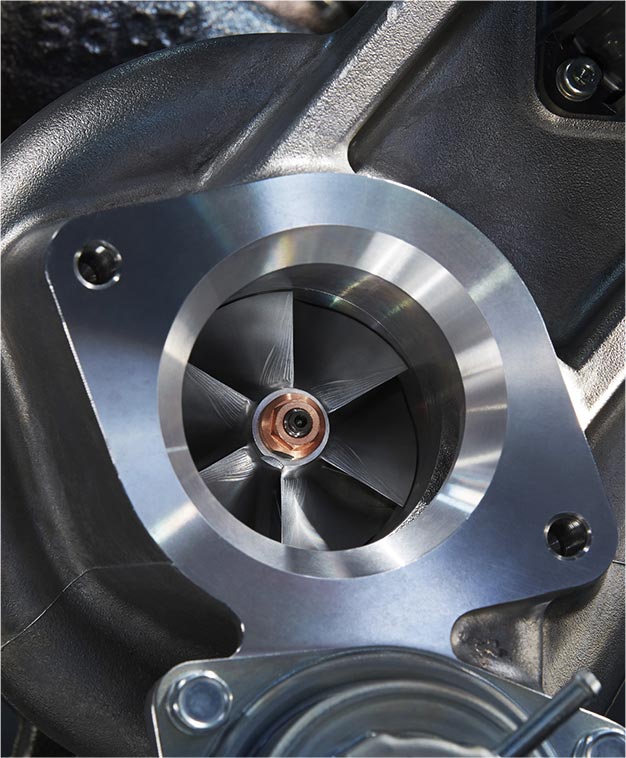
Compact turbocharger
with electronically-controlled wastegate
